RD Sharma Solutions for Class 9 Maths Chapter 5 – Free PDF Download
RD Sharma Solutions for Class 9 Maths Chapter 5 – Factorization of Algebraic Expressions are given here in detail. These study materials include five exercises, and all the questions are solved by BYJU’S subject experts. RD Sharma Class 9 Solutions Maths helps students to build the basics and in-depth understanding of the fundamental concepts. In this chapter, students will learn about the Factorization of Algebraic Expressions using the factorization method. The process of factorization can be defined as the disintegration of a term into smaller factors, whereas algebraic expressions are built up of variables, integer constants and basic arithmetic operations of algebra.
The expert faculty at BYJU’S have formulated RD Sharma Solutions based on the marks allotted to each step of a problem. The main objective is to help students in solving problems effortlessly and make the subject easier to understand. Our subject experts have provided chapter-wise solutions in a precise manner to boost students’ academic performance. Students can download the RD Sharma Solutions to score high marks in the examination.
RD Sharma Solutions for Class 9 Maths Chapter 5 Factorization of Algebraic Expressions
Access Answers to Maths RD Sharma Solutions for Class 9 Chapter 5 Factorization of Algebraic Expressions
Exercise 5.1 Page No: 5.9
Question 1: Factorize x3 + x – 3x2 – 3
Solution:
x3 + x – 3x2 – 3
Here x is common factor in x3 + x and – 3 is common factor in – 3x2 – 3
x3 – 3x2 + x – 3
x2 (x – 3) + 1(x – 3)
Taking ( x – 3) common
(x – 3) (x2 + 1)
Therefore x3 + x – 3x2 – 3 = (x – 3) (x2 + 1)
Question 2: Factorize a(a + b)3 – 3a2b(a + b)
Solution:
a(a + b)3 – 3a2b(a + b)
Taking a (a + b) as common factor
= a(a + b) {(a + b)2 – 3ab}
= a(a + b) {a2 + b2 + 2ab – 3ab}
= a(a + b) (a2 + b2 – ab)
Question 3: Factorize x(x3 – y3) + 3xy(x – y)
Solution:
x(x3 – y3) + 3xy(x – y)
= x(x – y) (x2 + xy + y2) + 3xy(x – y)
Taking x(x – y) as a common factor
= x(x – y) (x2 + xy + y2 + 3y)
= x(x – y) (x2 + xy + y2 + 3y)
Question 4: Factorize a2x2 + (ax2 + 1)x + a
Solution:
a2x2 + (ax2 + 1)x + a
= a2x2 + a + (ax2 + 1)x
= a(ax2 + 1) + x(ax2 + 1)
= (ax2 + 1) (a + x)
Question 5: Factorize x2 + y – xy – x
Solution:
x2 + y – xy – x
= x2 – x – xy + y
= x(x- 1) – y(x – 1)
= (x – 1) (x – y)
Question 6: Factorize x3 – 2x2y + 3xy2 – 6y3
Solution:
x3 – 2x2y + 3xy2 – 6y3
= x2(x – 2y) + 3y2(x – 2y)
= (x – 2y) (x2 + 3y2)
Question 7: Factorize 6ab – b2 + 12ac – 2bc
Solution:
6ab – b2 + 12ac – 2bc
= 6ab + 12ac – b2 – 2bc
Taking 6a common from first two terms and –b from last two terms
= 6a(b + 2c) – b(b + 2c)
Taking (b + 2c) common factor
= (b + 2c) (6a – b)
Question 8: Factorize (x2 + 1/x2) – 4(x + 1/x) + 6
Solution:
(x2 + 1/x2) – 4(x + 1/x) + 6
= x2 + 1/x2 – 4x – 4/x + 4 + 2
= x2 + 1/x2 + 4 + 2 – 4/x – 4x
= (x2) + (1/x) 2 + ( -2 )2 + 2x(1/x) + 2(1/x)(-2) + 2(-2)x
As we know, x2 + y2 + z2 + 2xy + 2yz + 2zx = (x+y+z) 2
So, we can write;
= (x + 1/x + (-2 )) 2
or (x + 1/x – 2) 2
Therefore, x2 + 1/x2) – 4(x + 1/x) + 6 = (x + 1/x – 2) 2
Question 9: Factorize x(x – 2) (x – 4) + 4x – 8
Solution:
x(x – 2) (x – 4) + 4x – 8
= x(x – 2) (x – 4) + 4(x – 2)
= (x – 2) [x(x – 4) + 4]
= (x – 2) (x2 – 4x + 4)
= (x – 2) [x2 – 2 (x)(2) + (2) 2]
= (x – 2) (x – 2) 2
= (x – 2)3
Question 10: Factorize ( x + 2 ) ( x2 + 25 ) – 10x2 – 20x
Solution :
( x + 2) ( x2 + 25) – 10x ( x + 2 )
Take ( x + 2 ) as common factor;
= ( x + 2 )( x2 + 25 – 10x)
=( x + 2 ) ( x2 – 10x + 25)
Expanding the middle term of ( x2 – 10x + 25 )
=( x + 2 ) ( x2 – 5x – 5x + 25 )
=( x + 2 ){ x (x – 5 ) – 5 ( x – 5 )}
=( x + 2 )( x – 5 )( x – 5 )
=( x + 2 )( x – 5 )2
Therefore, ( x + 2) ( x2 + 25) – 10x ( x + 2 ) = ( x + 2 )( x – 5 )2
Question 11: Factorize 2a2 + 2√6 ab + 3b2
Solution:
2a2 + 2√6 ab + 3b2
Above expression can be written as ( √2a )2 + 2 × √2a × √3b + ( √3b)2
As we know, ( p + q ) 2 = p2 + q2 + 2pq
Here p = √2a and q = √3b
= (√2a + √3b )2
Therefore, 2a2 + 2√6 ab + 3b2 = (√2a + √3b )2
Question 12: Factorize (a – b + c)2 + (b – c + a) 2 + 2(a – b + c) (b – c + a)
Solution:
(a – b + c)2 + ( b – c + a) 2 + 2(a – b + c) (b – c + a)
{Because p2 + q2 + 2pq = (p + q) 2}
Here p = a – b + c and q = b – c + a
= [a – b + c + b- c + a]2
= (2a)2
= 4a2
Question 13: Factorize a2 + b2 + 2( ab+bc+ca )
Solution:
a2 + b2 + 2ab + 2bc + 2ca
As we know, p2 + q2 + 2pq = (p + q) 2
We get,
= ( a+b)2 + 2bc + 2ca
= ( a+b)2 + 2c( b + a )
Or ( a+b)2 + 2c( a + b )
Take ( a + b ) as common factor;
= ( a + b )( a + b + 2c )
Therefore, a2 + b2 + 2ab + 2bc + 2ca = ( a + b )( a + b + 2c )
Question 14: Factorize 4(x-y) 2 – 12(x – y)(x + y) + 9(x + y)2
Solution :
Consider ( x – y ) = p, ( x + y ) = q
= 4p2 – 12pq + 9q2
Expanding the middle term, -12 = -6 -6 also 4× 9=-6 × -6
= 4p2 – 6pq – 6pq + 9q2
=2p( 2p – 3q ) -3q( 2p – 3q )
= ( 2p – 3q ) ( 2p – 3q )
= ( 2p – 3q )2
Substituting back p = x – y and q = x + y;
= [2( x-y ) – 3( x+y)]2 = [ 2x – 2y – 3x – 3y ] 2
= (2x-3x-2y-3y ) 2
=[ -x – 5y] 2
=[( -1 )( x+5y )] 2
=( x+5y ) 2
Therefore, 4(x-y) 2 – 12(x – y)(x + y) + 9(x + y)2 = ( x+5y )2
Question 15: Factorize a2 – b2 + 2bc – c2
Solution :
a2 – b2 + 2bc – c2
As we know, ( a-b)2 = a2 + b2 – 2ab
= a2 – ( b – c) 2
Also we know, a2 – b2 = ( a+b)( a-b)
= ( a + b – c )( a – ( b – c ))
= ( a + b – c )( a – b + c )
Therefore, a2 – b2 + 2bc – c2 =( a + b – c )( a – b + c )
Question 16: Factorize a2 + 2ab + b2 – c2
Solution:
a2 + 2ab + b2 – c2
= (a2 + 2ab + b2) – c2
= (a + b)2 – (c) 2
We know, a2 – b2 = (a + b) (a – b)
= (a + b + c) (a + b – c)
Therefore a2 + 2ab + b2 – c2 = (a + b + c) (a + b – c)
Exercise 5.2 Page No: 5.13
Factorize each of the following expressions:
Question 1: p3 + 27
Solution:
p3 + 27
= p3 + 33
[using a3 + b3 = (a + b)(a2 –ab + b2)]
= (p + 3)(p² – 3p – 9)
Therefore, p3 + 27 = (p + 3)(p² – 3p – 9)
Question 2: y3 + 125
Solution:
y3 + 125
= y3 + 53
[using a3 + b3 = (a + b)(a2 –ab + b2)]
= (y+5)(y2 − 5y + 52)
= (y + 5)(y2 − 5y + 25)
Therefore, y3 + 125 = (y + 5)(y2 − 5y + 25)
Question 3: 1 – 27a3
Solution:
= (1)3 −(3a) 3
[using a3 – b3 = (a – b)(a2 + ab + b2)]
= (1− 3a)(12 + 1×3a + (3a) 2)
= (1−3a)(1 + 3a + 9a2)
Therefore, 1−27a3 = (1−3a)(1 + 3a+ 9a2)
Question 4: 8x3y3 + 27a3
Solution:
8x3y3 + 27a3
= (2xy) 3 + (3a) 3
[using a3 + b3 = (a + b)(a2 –ab + b2)]
= (2xy +3a)((2xy)2−2xy×3a+(3a) 2)
= (2xy+3a)(4x2y2 −6xya + 9a2)
Question 5: 64a3 − b3
Solution:
64a3 − b3
= (4a)3−b3
[using a3 – b3 = (a – b)(a2 + ab + b2)]
= (4a−b)((4a)2 + 4a×b + b2)
=(4a−b)(16a2 +4ab+b2)
Question 6: x3 / 216 – 8y3
Solution:
x3 / 216 – 8y3

Question 7: 10x4 y – 10xy4
Solution:
10x4 y – 10xy4
= 10xy(x3 − y3)
[using a3 – b3 = (a – b)(a2 + ab + b2)]
= 10xy (x−y)(x2 + xy + y2)
Therefore, 10x4 y – 10xy4 = 10xy (x−y)(x2 + xy + y2)
Question 8: 54x6 y + 2x3y4
Solution:
54x6 y + 2x3y4
= 2x3y(27x3 +y3)
= 2x3y((3x) 3 + y3)
[using a3 + b3 = (a + b)(a2 – ab + b2)]
= 2x3y {(3x+y) ((3x)2−3xy+y2)}
=2x3y(3x+y)(9x2 − 3xy + y2)
Question 9: 32a3 + 108b3
Solution:
32a3 + 108b3
= 4(8a3 + 27b3)
= 4((2a) 3+(3b) 3)
[using a3 + b3 = (a + b)(a2 – ab + b2)]
= 4[(2a+3b)((2a)2−2a×3b+(3b) 2)]
= 4(2a+3b)(4a2 − 6ab + 9b2)
Question 10: (a−2b)3 − 512b3
Solution:
(a−2b)3 − 512b3
= (a−2b)3 −(8b) 3
[using a3 – b3 = (a – b)(a2 + ab + b2)]
= (a −2b−8b) {(a−2b)2 + (a−2b)8b + (8b) 2}
=(a −10b)(a2 + 4b2 − 4ab + 8ab − 16b2 + 64b2)
=(a−10b)(a2 + 52b2 + 4ab)
Question 11: (a+b)3 − 8(a−b)3
Solution:
(a+b)3 − 8(a−b)3
= (a+b)3 − [2(a−b)]3
= (a+b)3 − [2a−2b] 3
[using p3 – q3 = (p – q)(p2 + pq + q2)]
Here p = a+b and q = 2a−2b
= (a+b−(2a−2b))((a+b)2+(a+b)(2a−2b)+(2a−2b) 2)
=(a+b−2a+2b)(a2+b2+2ab+(a+b)(2a−2b)+(2a−2b) 2)
=(a+b−2a+2b)(a2+b2+2ab+2a2−2ab+2ab−2b2+(2a−2b) 2)
=(3b−a)(3a2+2ab−b2+(2a−2b) 2)
=(3b−a)(3a2+2ab−b2+4a2+4b2−8ab)
=(3b−a)(3a2+4a2−b2+4b2−8ab+2ab)
=(3b−a)(7a2+3b2−6ab)
Question 12: (x+2)3 + (x−2) 3
Solution:
(x+2)3 + (x−2) 3
[using p3 + q3 = (p + q)(p2 – pq + q2)]
Here p = x + 2 and q = x – 2
= (x+2+x−2)((x+2)2−(x+2)(x−2)+(x−2) 2)
=2x(x2 +4x+4−(x+2)(x−2)+x2−4x+4)
[ Using : (a+b)(a−b) = a2−b2 ]
= 2x(2x2 + 8 − (x2 − 22))
= 2x(2x2 +8 − x2 + 4)
= 2x(x2 + 12)
Exercise 5.3 Page No: 5.17
Question 1: Factorize 64a3 + 125b3 + 240a2b + 300ab2
Solution:
64a3 + 125b3 + 240a2b + 300ab2
= (4a)3 + (5b) 3 + 3(4a)2(5b) + 3(4a)(5b)2 , which is similar to a3 + b3 + 3a2b + 3ab2
We know that, a3 + b3 + 3a2b + 3ab2 = (a+b)3]
= (4a+5b)3
Question 2: Factorize 125x3 – 27y3 – 225x2y + 135xy2
Solution:
125x3 – 27y3 – 225x2y + 135xy2
Above expression can be written as (5x)3−(3y) 3−3(5x)2(3y) + 3(5x)(3y)2
Using: a3 − b3 − 3a2b + 3ab2 = (a−b)3
= (5x − 3y)3
Question 3: Factorize 8/27 x3 + 1 + 4/3 x2 + 2x
Solution:
8/27 x3 + 1 + 4/3 x2 + 2x

Question 4: Factorize 8x3 + 27y3 + 36x2y + 54xy2
Solution:
8x3 + 27y3 + 36x2y + 54xy2
Above expression can be written as (2x)3 + (3y) 3 + 3×(2x)2×3y + 3×(2x)(3y)2
Which is similar to a³ + b³ + 3a²b + 3ab² = (a + b) ³]
Here a = 2x and b = 3y
= (2x+3y)3
Therefore, 8x3 + 27y3 + 36x2y + 54xy2 = (2x+3y)3
Question 5: Factorize a3 − 3a2b + 3ab2 − b3 + 8
Solution:
a3 − 3a2b + 3ab2 − b3 + 8
Using: a3 − b3 − 3a2b + 3ab2 = (a−b)3
= (a−b)3 + 23
Again , Using: a3 + b3 =(a + b)(a2 – ab + b2)]
=(a−b+2)((a−b)2−(a−b) × 2 + 22)
=(a−b+2)(a2+b2−2ab−2(a−b)+4)
=(a−b+2)(a2+b2−2ab−2a+2b+4)
a3 − 3a2b + 3ab2 − b3 + 8 =(a−b+2)(a2+b2−2ab−2a+2b+4)
Exercise 5.4 Page No: 5.22
Factorize each of the following expressions:
Question 1: a3 + 8b3 + 64c3 − 24abc
Solution:
a3 + 8b3 + 64c3 − 24abc
= (a)3 + (2b) 3 + (4c) 3− 3×a×2b×4c
[Using a3+b3+c3−3abc = (a+b+c)(a2+b2+c2−ab−bc−ca)]
= (a+2b+4c)(a2+(2b)2 + (4c)2−a×2b−2b×4c−4c×a)
= (a+2b+4c)(a2 +4b2 +16c2 −2ab−8bc−4ac)
Therefore, a3 + 8b3 + 64c3 − 24abc = (a+2b+4c)(a2 +4b2 +16c2 −2ab−8bc−4ac)
Question 2: x 3 − 8y 3+ 27z3 + 18xyz
Solution:
= x3 − (2y) 3 + (3z) 3 − 3×x×(−2y)(3z)
= (x + (−2y) + 3z) (x2 + (−2y)2 + (3z) 2 −x(−2y)−(−2y)(3z)−3z(x))
[using a3+b3+c3−3abc = (a+b+c)(a2+b2+c2−ab−bc−ca)]
=(x −2y + 3z)(x2 + 4y2 + 9 z2 + 2xy + 6yz − 3zx)
Question 3: 27x 3 − y 3– z3 – 9xyz
Solution:
27x 3 − y 3– z3 – 9xyz
= (3x) 3 − y 3– z3 – 3(3xyz)
[Using a3 + b3 + c3 −3abc = (a + b + c)(a2+b2+c2−ab−bc−ca)]
Here a = 3x, b = -y and c = -z
= (3x – y – z){ (3x)2 + (- y)2 + (– z)2 + 3xy – yz + 3xz)}
= (3x – y – z){ 9x2 + y2 + z2 + 3xy – yz + 3xz)}
Question 4: 1/27 x3 − y3 + 125z3 + 5xyz
Solution:
1/27 x3 − y3 + 125z3 + 5xyz
= (x/3)3+(−y)3 +(5z)3 – 3 x/3 (−y)(5z)
[Using a3 + b3 + c3 −3abc = (a + b + c)(a2+b2+c2−ab−bc−ca)]
= (x/3 + (−y) + 5z)((x/3)2 + (−y)2 + (5z) 2 –x/3(−y) − (−y)5z−5z(x/3))
= (x/3 −y + 5z) (x^2/9 + y2 + 25z2 + xy/3 + 5yz – 5zx/3)
Question 5: 8x3 + 27y3 − 216z3 + 108xyz
Solution:
8x3 + 27y3 − 216z3 + 108xyz
= (2x) 3 + (3y) 3 +(−6y) 3 −3(2x)(3y)(−6z)
= (2x+3y+(−6z)){ (2x)2+(3y) 2+(−6z) 2 −2x×3y−3y(−6z)−(−6z)2x}
= (2x+3y−6z) {4x2 +9y2 +36z2 −6xy + 18yz + 12zx}
Question 6: 125 + 8x3 − 27y3 + 90xy
Solution:
125 + 8x3 − 27y3 + 90xy
= (5)3 + (2x) 3 +(−3y) 3 −3×5×2x×(−3y)
= (5+2x+(−3y)) (52 +(2x) 2 +(−3y) 2 −5(2x)−2x(−3y)−(−3y)5)
= (5+2x−3y)(25+4x2 +9y2 −10x+6xy+15y)
Question 7: (3x−2y)3 + (2y−4z) 3 + (4z−3x) 3
Solution:
(3x−2y)3 + (2y−4z) 3 + (4z−3x) 3
Let (3x−2y) = a, (2y−4z) = b , (4z−3x) = c
a + b + c= 3x−2y+2y−4z+4z−3x = 0
We know, a3 + b3 + c3 −3abc = (a + b + c)(a2+b2+c2−ab−bc−ca)
⇒ a3 + b3 + c3 −3abc = 0
or a3 + b3 + c3 =3abc
⇒ (3x−2y)3 + (2y−4z) 3 + (4z−3x) 3 = 3(3x−2y)(2y−4z)(4z−3x)
Question 8: (2x−3y)3 + (4z−2x) 3 + (3y−4z) 3
Solution:
(2x−3y)3 + (4z−2x) 3 + (3y−4z) 3
Let 2x – 3y = a , 4z – 2x = b , 3y – 4z = c
a + b + c= 2x – 3y + 4z – 2x + 3y – 4z = 0
We know, a3 + b3 + c3 −3abc = (a + b + c)(a2+b2+c2−ab−bc−ca)
⇒ a3 + b3 + c3 −3abc = 0
(2x−3y)3 + (4z−2x) 3 + (3y−4z) 3 = 3(2x−3y)(4z−2x)(3y−4z)
Exercise VSAQs Page No: 5.24
Question 1: Factorize x4 + x2 + 25
Solution:
x4 + x2 + 25
= (x2) 2 + 52 + x2
[using a2 + b2 = (a + b) 2 – 2ab ]
= (x2 +5) 2 −2(x2 ) (5) + x2
=(x2 +5) 2 −10x2 + x2
=(x2 + 5) 2 − 9x2
=(x2 + 5) 2 − (3x) 2
[using a2 – b2 = (a + b)(a – b ]
= (x 2 + 3x + 5)(x2 − 3x + 5)
Question 2: Factorize x2 – 1 – 2a – a2
Solution:
x2 – 1 – 2a – a2
x2 – (1 + 2a + a2 )
x2 – (a + 1)2
(x – (a + 1)(x + (a + 1)
(x – a – 1)(x + a + 1)
[using a2 – b2 = (a + b)(a – b) and (a + b)^2 = a^2 + b^2 + 2ab ]
Question 3: If a + b + c =0, then write the value of a3 + b3 + c3.
Solution:
We know, a3 + b3 + c3 – 3abc = (a + b +c ) (a2 + b2 + c2 – ab – bc − ca)
Put a + b + c =0
This implies
a3 + b3 + c3 = 3abc
Question 4: If a2 + b2 + c2 = 20 and a + b + c =0, find ab + bc + ca.
Solution:
We know, (a+b+c)² = a² + b² + c² + 2(ab + bc + ca)
0 = 20 + 2(ab + bc + ca)
-10 = ab + bc + ca
Or ab + bc + ca = -10
Question 5: If a + b + c = 9 and ab + bc + ca = 40, find a2 + b2 + c2 .
Solution:
We know, (a+b+c)² = a² + b² + c² + 2(ab + bc + ca)
92 = a² + b² + c² + 2(40)
81 = a² + b² + c² + 80
⇒ a² + b² + c² = 1
RD Sharma Solutions for Class 9 Maths Chapter 5 Factorization of Algebraic Expressions
In the 5th Chapter of Class 9 RD Sharma Solutions, students will study important topics, as listed below:
- Factorization by taking out the common factors
- Factorization by grouping the terms
- Factorization by making a perfect square
- Factorization by the difference of two squares
- Factorization of quadratic polynomials by splitting the middle term
- Factorization of algebraic expressions expressible as the sum or difference of two cubes
Students who want to gain proficiency in Mathematics are advised to practise textbook questions as many times as possible, using solutions provided at BYJU’S website. This also helps them to score high marks in the final examination.
Frequently Asked Questions on RD Sharma Solutions for Class 9 Maths Chapter 5
Mention the topics present in RD Sharma Solutions for Class 9 Maths Chapter 5.
1. Factorization by taking out the common factors
2. Factorization by grouping the terms
3. Factorization by making a perfect square
4. Factorization by the difference of two squares
5. Factorization of quadratic polynomials by splitting the middle term
6. Factorization of algebraic expressions expressible as the sum or difference of two cubes.


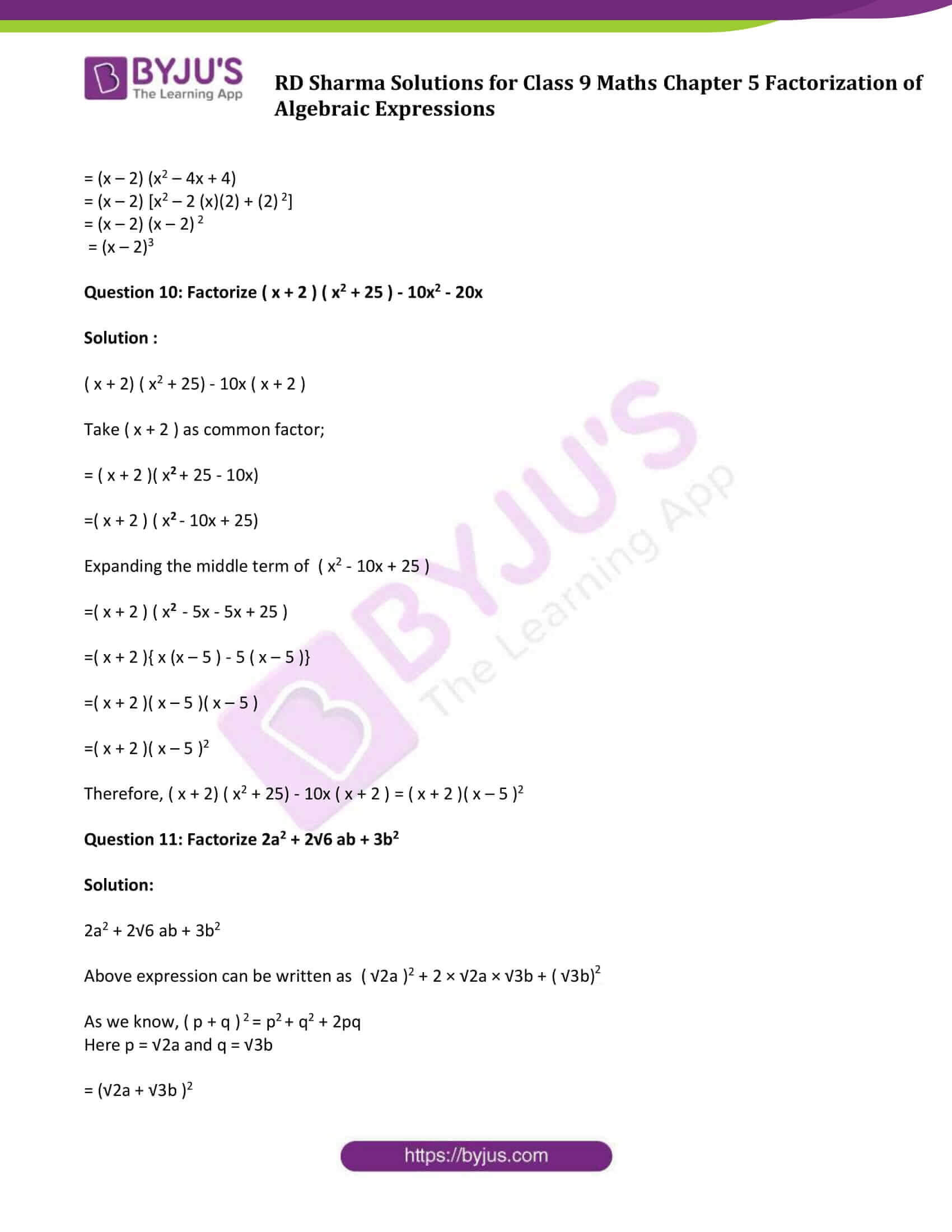





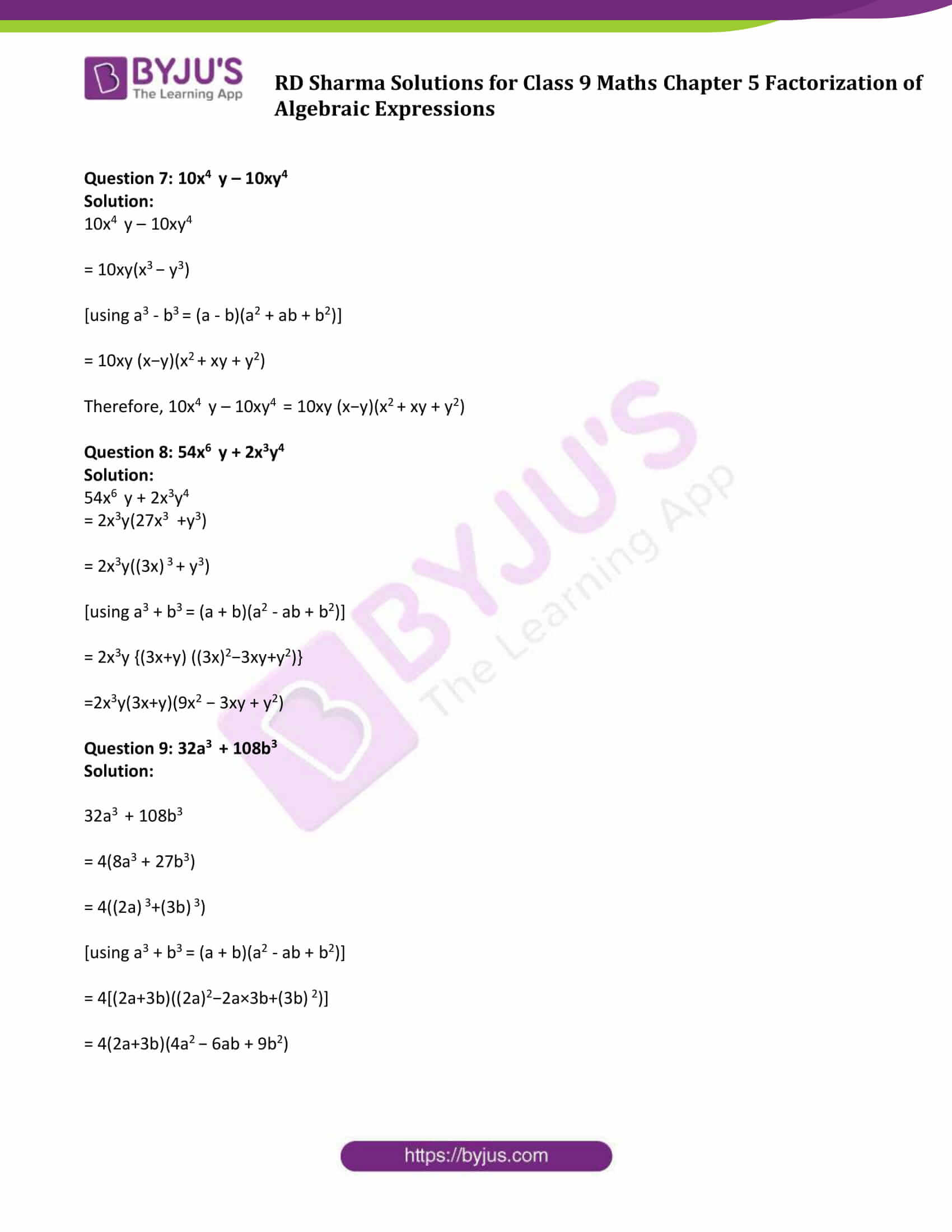

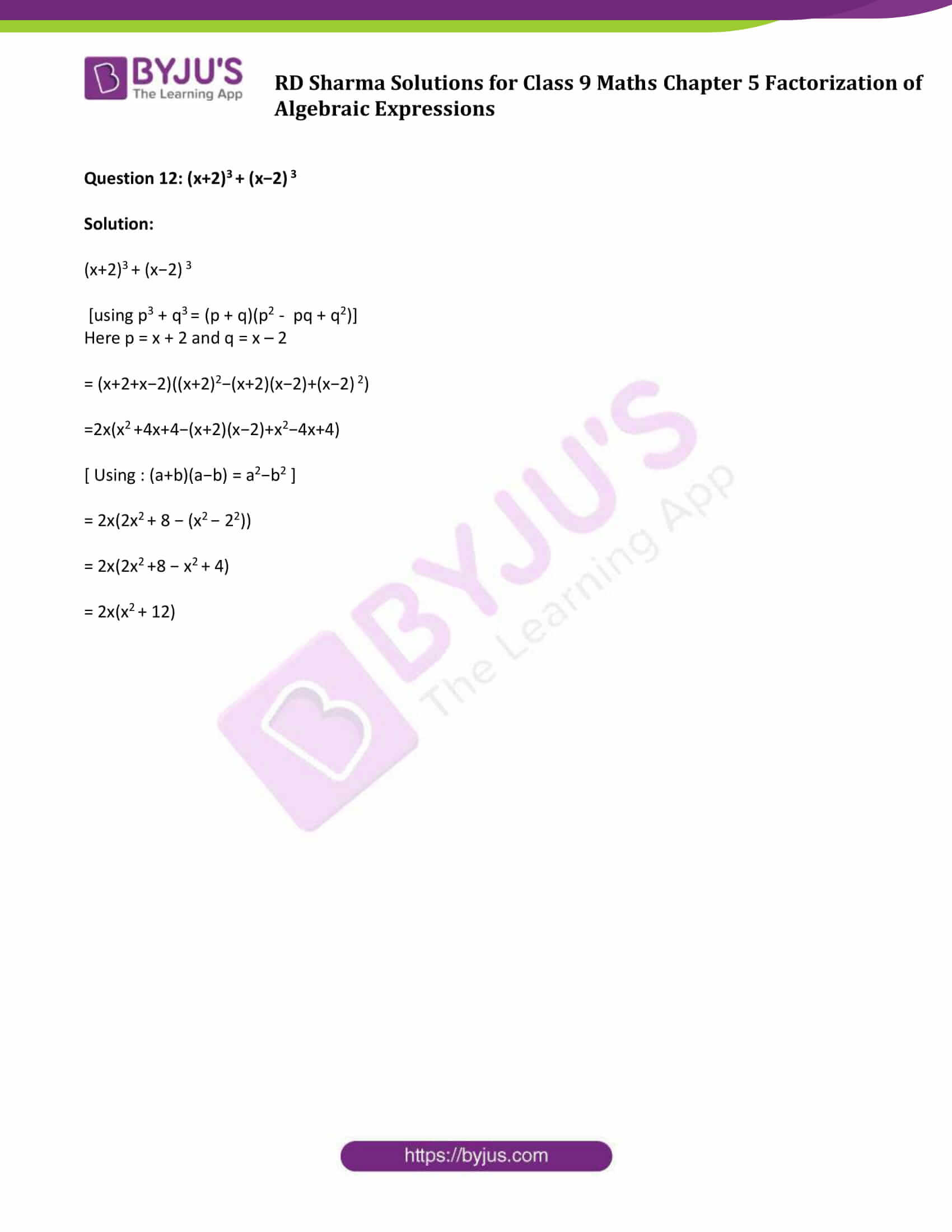
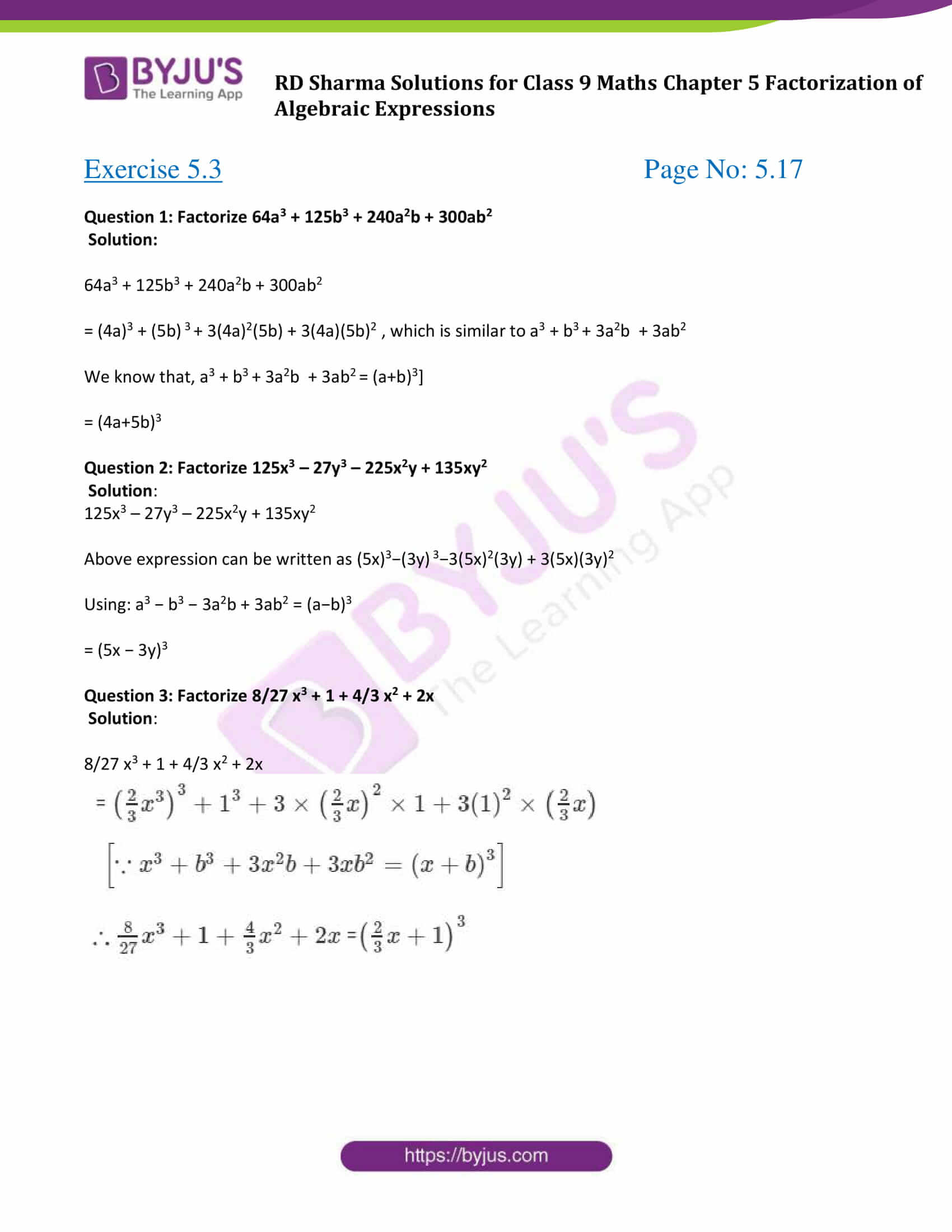



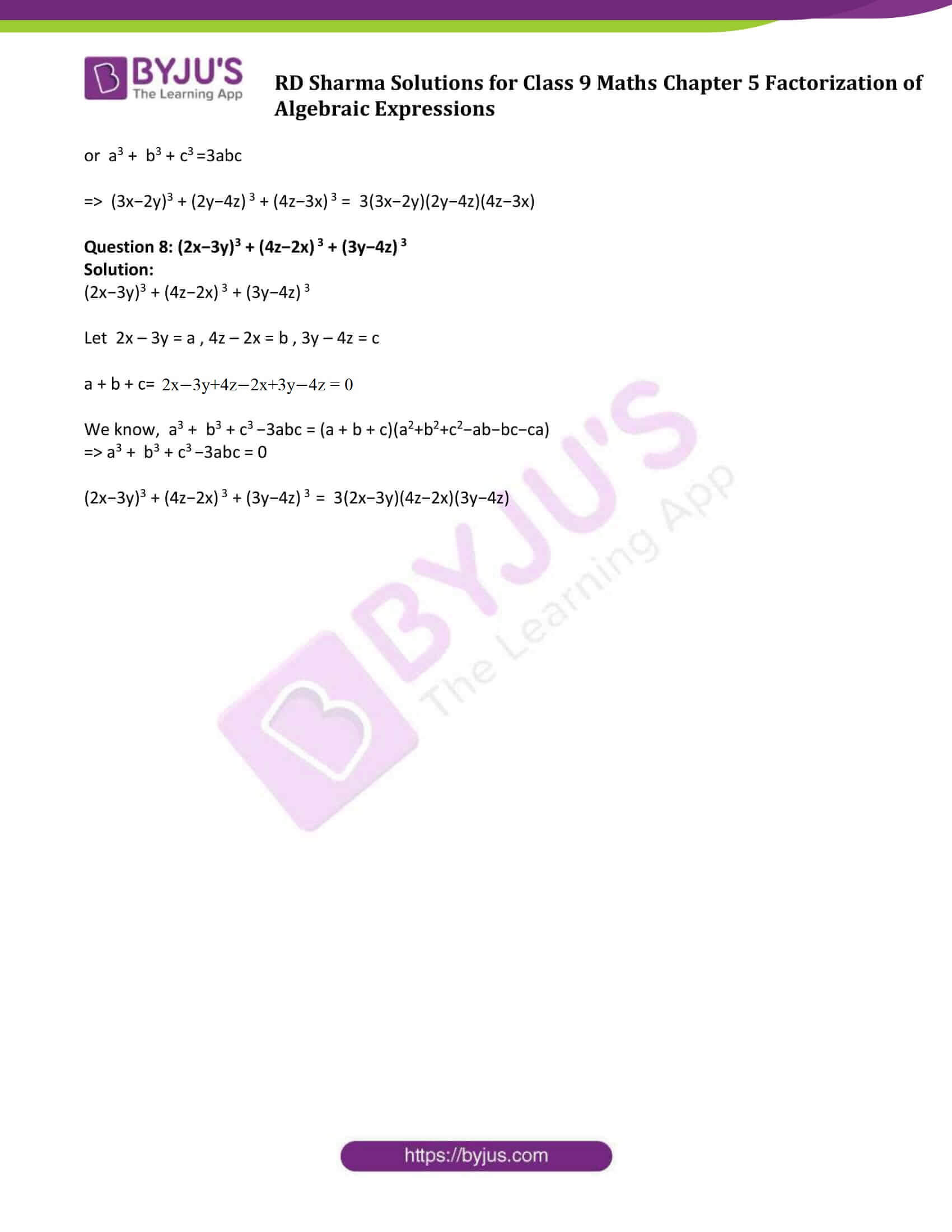


Comments